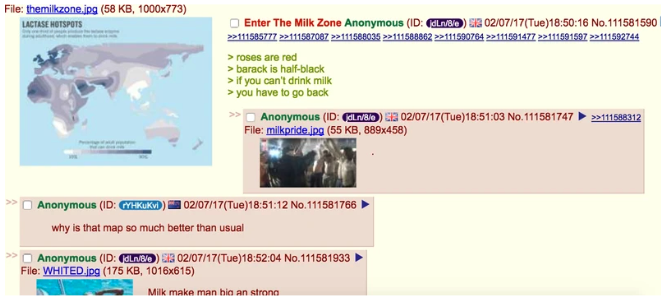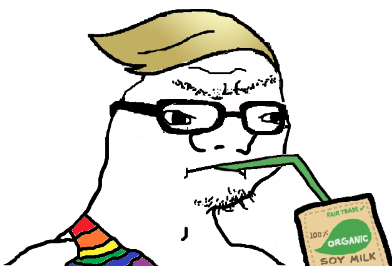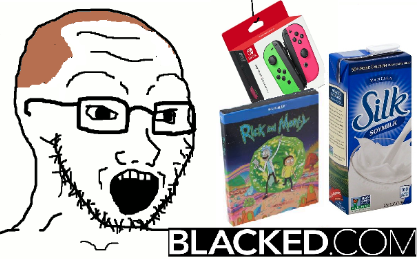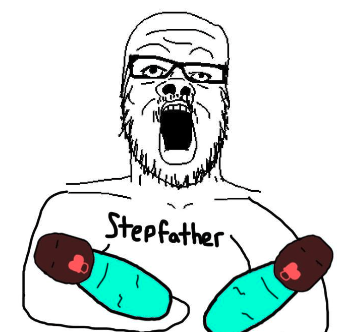Introduction
The imagery and symbolism associated with milk – from fertility and motherhood to purity and strength – have long been an inspiration in art, cinema and literature. The alt-right has strategically drawn on this imagery and constructed a digital landscape that revolves around milk and its associations to purity and strength – specifically white purity and strength. In its deployment by the alt-right, the symbol of dairy milk, therefore, figures as an assertion of white supremacy, racial purity and the traditional gender order.
More recently, this narrative has also found its home within the digital culture of memes. Most prominently, the vernacular term ‘Soyboy’ – deployed as a derision of deviant or non-hegemonic masculinities – is now visually articulated in the form of the ‘Soyjak’ meme. Against this backdrop, this Insight examines the alt-right’s strategic deployment of dairy milk as a white supremacist symbol, and its connection to the wider alt-right metapolitical project. By focusing specifically on the figure of the Soyjak, the emphasis here is on the memefication of hateful rhetoric, which serves to normalise fascism by transforming it not just into a palatable ideology, but also into a consumable product that is considered attractive or edgy.
Setting the Stage: The Origins of #MilkTwitter
In 2017, a group of alt-right protesters interrupted actor Shia LaBeouf’s anti-Trump art installation titled He Will Not Divide Us. Now commonly dubbed the ‘milk party’, the centrepiece of this alt-right protest was dairy milk: protesters, many shirtless, showed up with half-gallons of milk, which they chugged while chanting about ‘cucks’ and the ‘vegan agenda’. #MilkTwitter went viral following the events at the art installation, and the hashtag was soon populated by a number of racist, anti-Semitic tweets. Soon thereafter, Richard Spencer – who is infamously attributed with coining the term ‘alt-right’ – included a milk emoji in his Twitter bio, along with the caption “I’m very tolerant … lactose tolerant!” (Fig. 1).

Fig. 1: Richard Spencer’s Twitter bio
Understood in a vacuum, the thought of a group of men drinking full-fat milk straight out of the bottle seems inane, probably even comical. However, as this Insight will show, this imagery is closely linked to the already established white supremacist discourse of dietary racism. At the heart of both the protestors’ and Spencer’s messaging is the notion that there exists a firm link between dairy milk consumption and white genetic superiority, strength and virility. In this sense, the act of drinking milk is cast metapolitically as a reassertion of white masculinity and a revitalisation of atavistic masculine values. As such, understanding the appropriation of dairy milk as a symbol of hate can reveal to us a lot about the gendered and raced logics central to the alt-right worldview.
Dietary Racism
The central tropes underlying the alt-right’s milk-related messaging are not a new phenomenon. The discourse of dietary racism pervaded well throughout the 19th century and was commonly endorsed by the medical community, which distinguished between the “effeminate rice eaters of India and China” and the “superior moral courage […] of meat-eating Englishmen”. Milk consumption, therefore, became a proxy for white privilege, legitimated by colonial logics: the ‘leaf diet’ represented colonial subjection, effeminacy and degeneracy, while the meat-eating, milk-drinking represented colonial conquest and racial superiority. The discourse underlying dietary racism, therefore, is one that is firmly embedded in the development of the Western capitalist nation state. As a ’natural’ food that could be managed and improved through modern technologies of pasteurisation, homogenisation, and standardisation, it came to symbolise “modern progress in the Western world”. Milk’s symbolism as natural and pure, therefore, cannot be disentangled from its historical narrative and its link to structures of colonialism and racial capitalism.
In 2013, a graphic published in Nature echoed this familiar narrative by putting forth the argument that lactose tolerance has historically acted as an evolutionary advantage. The graphic was soon taken up by the 4chan thread ‘Enter the Milk Zone’, where it was reproduced alongside several racist comments (Fig. 2 – Please note that the following screenshot contains racist hate speech).

Fig. 2: Screenshot from ‘Enter the Milk Zone’ subreddit
While the original Nature article certainly is not responsible for the alt-right’s racist ideologies, it did capture the longstanding discourse of dietary racism and provided a kind of academic legitimacy for the alt-right to borrow from. What we clearly see in the case of the alt-right’s appropriation of dairy milk as a symbol of white supremacy, therefore, is a continuum of the racially and colonially-driven narrative of dietary racism popularised in the 19th century. What is at stake in the debate over dairy milk consumption is not just the product itself, but its symbolism, imagery and the historical political discourse around it. The alt-right’s call to take down the ‘vegan agenda’, therefore, is a call to the revival of white supremacy, white masculinity and the white nation-state.
Soyboys and Soyjaks
Memetically, the trope of the soy boy is articulated most notably in the form of Soyjak, which is a derivative of the now widespread Wojak meme (also known as the so-called Feels Guy). Because of its versatility, the basic Wojak has been adapted to various contexts and narratives that have made it a fertile breeding ground for alt-right messaging. As a remixed articulation of Wojak, Soyjak has become a stand-in figure for subordinate masculinity, most often through his veneration of symbolism, imagery and ideologies associated with left-wing politics (Fig. 3). The character’s name specifically refers to the fact that he drinks soy milk (rather than dairy milk), which is considered weak and effeminate. In this sense, he becomes a memetic articulation of the discourse of dietary racism outlined above.

Fig. 3: Soyjak meme
Notably, Soyjak is often depicted alongside other symbols associated with left-wing or ‘woke’ political ideology and supposedly emasculating behaviour. These symbols include not only vegan milk alternatives but also the rainbow flag (Fig. 3) gaming (Fig. 4) and an affinity for so-called cuck pornography (Fig. 4 and 5).

Fig. 4: Meme associating soy milk with gaming
Soyjak is coded as weak and effeminate for a number of reasons: first and foremost through his consumption of non-dairy milk; but also through his affinity for gaming and other ‘geeky’ pastimes; and finally, through his own involvement in the ’degeneration’ of white masculinity. A notable articulation of the Soyjak’s supposed effeminacy, therefore, relates to the trope of the cuck (Fig. 5), whose figure is made legible through the perceived sexual humiliation of white men, white racial anxiety and injured white masculinity. In this articulation of the meme, the cucked Soyjak willingly and happily submits to the racial ‘other’, thereby making him complicit in the “defilement of white racial purity”. Soyjak, through his discursive proximity to the trope of the cuck, therefore, is part of the alt-right’s memetic fetishisation of white reproduction. As such, the symbol of milk – through its associations with purity and motherhood, but also through its relationship to the white nation-state – is neither arbitrary nor innocuous, but strategic to the alt-right’s violent rhetoric.

Fig. 5: ‘Cuck’ meme
The Alt-Right and the Metapolitics of Memes
At this point, it makes sense to focus on a specific phenomenon that makes up a core part of the alt-right strategy, namely its commitment to “metapolitical activism”. In its most basic sense, the alt-right’s use of metapolitics refers to a pre-political approach to white supremacy and seeks to appeal to the hearts and minds of the audience. Central to this is the idea that “politics is downstream of culture” – a phrase popularised by Andrew Breitbart. Metapolitics, therefore, is central to the American alt-right belief that they find themselves in the midst of a cultural war that necessarily precedes a political takeover.
A core proponent of the alt-right’s adoption of metapolitics has been Greg Johnson, whose website and right-wing publishing house, Counter-Currents Publishing, has been a key player in the alt-right metapolitical project. In a blog post from 2018, Johnson defines metapolitics as “soft power that ultimately reduces to persuasion” and explicitly proclaims that “actual politics comes later, once we have laid the metapolitical groundwork”.
Understanding the alt-right’s emphasis on metapolitics, therefore, offers an entry point into conceptualising the link between dietary racism, its historical context, and its digital manifestations in meme culture. The fact that the alt-right’s origins align so closely with online trolling culture means that from the very start, the movement was imbued with a strategically casual stance towards symbolism and imagery of hatred. This casual stance has been carried on throughout the movement’s metapolitical efforts to normalise and mainstream hate. It is therefore crucial to consider the alt-right’s metapolitical strategy alongside its subcultural history of online trolling and its meme culture. The Soyjak meme and more broadly, the assertion of milk as a symbol of white supremacy, sit very comfortably within this context.
Conclusion
Through the use of dog whistles and seemingly innocuous symbols, the metapolitical strategy adopted by the alt-right projects “a manicured image and an emphasis on their [the alt-right’s] banal normalcy of wanting their children to grow up in a nation that resembles that imagined community often stylized in Norman Rockwell paintings.” The Soyjak meme represents a clear example of the memetic metapoliticisation of dairy milk consumption as a reaffirmation of white masculinity and the white hetero-patriarchal gender order. Furthermore, this attempted normalisation of fascism through metapolitics links closely with the alt-right’s distinct culture of memes and trolling, as both are part of a greater effort to widen the movement’s appeal. Understanding both the historical context and contemporary articulations of the Soyjak meme, therefore, is crucial to following the alt-right’s ever-evolving media strategies.
